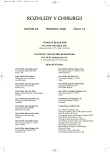Treatment of Diaphyseal Forearm Fractures with Locking Intramedullary Nail
Ošetření diafyzárních zlomenin předloktí pomocí zajištěného nitrodřeňového hřebu
Úvod:
Cílem práce je zhodnotit výsledky ošetření diafyzárních zlomenin radia a ulny pomocí zajištěného nitrodřeňového hřebu.
Metodika:
45 pacientů s 68 zlomeninami bylo v období 2003–2005 ošetřeno nitrodřeňovým hřebem ForeSight (Smith&Nephew, USA). Průměrný věk pacientů byl 34,12 roku. V pooperačním období byly sledovány časné i pozdní komplikace, byly vyhodnoceny RTG snímky a funkční výsledky.
Výsledky:
Průměrná doba kostního zhojení byla 13,2 týdne, zaznamenali jsme 3 případy prodlouženého hojení a žádný případ pakloubu. Při hodnocení funkčních výsledků podle Andersona jsme zaznamenali plný rozsah pohybu u 86,9 % pacientů, lehké omezení pohybu u 10,9 % a těžké omezení u 2,2 % pacientů. Z pooperačních komplikací jsme zaznamenali 1x povrchovou infekci, 2 případy inkompletní radioulnární synostózy a v jednom případě se rozvinul kompartment syndrom.
Závěr:
Při porovnání dlahové techniky a hřebování jsme dosáhli srovnatelných výsledků a implantát považujeme za vhodný k použití především u otevřených, etážových a široce kominutivních zlomenin předloketních kostí.
Klíčová slova:
diafyzární zlomeniny předloktí – zajištěný nitrodřeňový hřeb – ForeSight systém
Authors:
P. Višňa; J. Kalvach; M. Valcha; E. Beitl; Martin Vlček
Authors‘ workplace:
Traumatologické oddělení, Chirurgická klinika UK 2. LF a FN Motol, Praha, přednosta
prof. MUDr. J. Hoch, CSc.
Published in:
Rozhl. Chir., 2006, roč. 85, č. 12, s. 631-636.
Category:
Monothematic special - Original
Overview
Introduction:
The aim of this study is to evaluate the results after treating diaphyseal fractures of the forearm with an interlocking intramedullary nail.
Methods:
Between 2003 and 2005, 45 patients with 68 fractures were treated using the ForeSight intramedullary nail (Smith&Nephew, Memphis, USA). The average patient age was 34.12 years. In the postoperative period, early and late complications were evaluated through radiological and functional methods.
Results:
The average length of time to demonstrated bone healing was 13.2 weeks. 3 cases of prolonged healing were observed, and pseudoarthrosis formation did not occur. Assessment of function according to Anderson gave the following results: full range of movement in 86.9% of patients; mild restriction of movement in 10.9%; and severe restriction of movement in 2.2% of patients. Postoperative complications included: 1 superficial infection, 2 cases of incomplete radioulnar synostosis; and one case of compartment syndrome.
Conclusions:
Upon comparing the techniques of using plates with those of nailing in the treatment of forearm fractures, we have achieved comparable results with nailing, and we therefore regard it as advantageous foremost for treating open, serial and grossly comminuted fractures of the forearm bones.
Key words:
diaphyseal forearm fractures – intramedullary interlocking nailing – ForeSight system
Labels
Surgery Orthopaedics Trauma surgeryArticle was published in
Perspectives in Surgery

2006 Issue 12
- Metamizole vs. Tramadol in Postoperative Analgesia
- Metamizole at a Glance and in Practice – Effective Non-Opioid Analgesic for All Ages
- Current Insights into the Antispasmodic and Analgesic Effects of Metamizole on the Gastrointestinal Tract
Most read in this issue
- Consequennce of Nontreatment Scapholunate Instability of the Wrist
- Anterior Skull Base Reconstruction
- Autovenous Ilicofemoral Bypass, 21 Years Later – A Case-Review
- Chylothorax. A Case Review and Literature Overview
